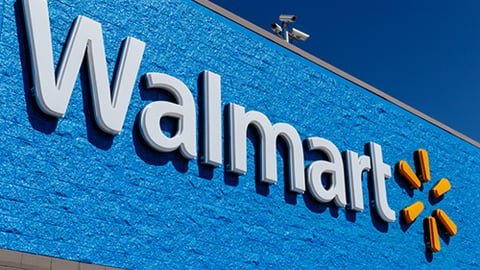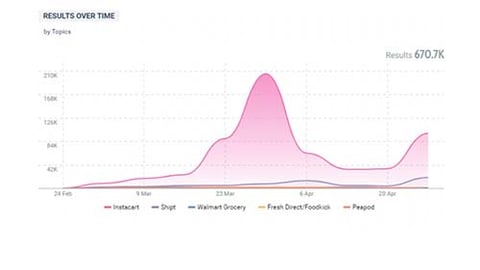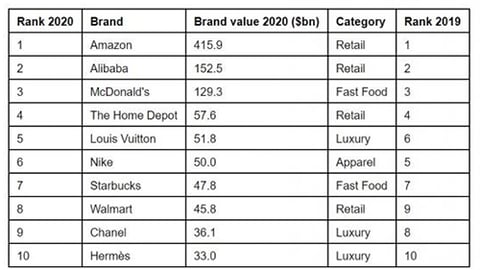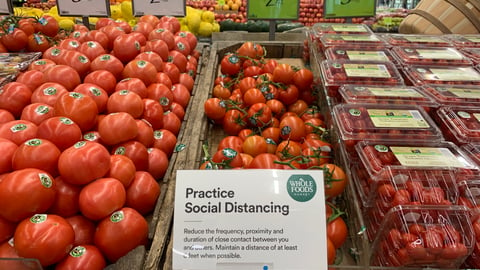Will Online Grocery Shoppers Prefer Amazon or Walmart?
Most shoppers plan to buy groceries online this year, a trend fueled by pandemic stay-at-home orders, and an indication of the outbreak could lead to permanent shifts in food retail. That finding comes from new research that also provides an update about the ongoing competition between Amazon and Walmart to capture more grocery spend.
A report from Coresight Research found that, for the first time, more than half of consumers — 52% — have bought groceries via online channels this year. That’s double the rate from two years. As well, 62.5% of consumers “expect to buy groceries online in the next 12 months, likely supported by demand amid the coronavirus crisis.” Food retailers, as a whole, remain behind the e-commerce and mobile curve compared to other merchants, but online and mobile shopping was gaining popularity among grocery shoppers before the pandemic started to encourage even more growth in that area.
Coresight based its “U.S. Online Grocery Survey: 2020” on a mid-March survey of 1,152 U.S. consumers. “Online sales are growing fast—by an estimated 22% in 2019—and we see the market growing by approximately 40% this year, supported by much higher growth during lockdowns,” Coresight said. “That would equate to almost $38 billion of online food and beverage sales in 2020, or around 3.5% of the total market.”
The survey report also indicates that consumers are quickly becoming more comfortable with buying more food and grocery items online — the type of finding that could help inform food retailers’ marketing, merchandising, staffing and even loyalty program plans down the road. “Respondents bought an average of 5.0 grocery categories online this year, versus 4.4 categories in last year’s survey, reflecting ecommerce’s shift from one-off product purchases to full-basket grocery shops of the kind that are undertaken in supermarkets,” Coresight found.
As online grocery shopping gains popularity, consumers are starting to see that channel more as an extension of a physical store rather than something different or special, at least going by the Coresight findings. “We saw significant increases in the proportion of online shoppers buying fresh dairy, meat, fish or eggs and bakery products,” the report said, “further suggesting that consumers are adopting e-commerce as a channel for regular grocery shops and not just for ambient or nonfood store-cupboard goods.
As more consumers turn to online and mobile channels to buy their groceries, food retailers have to keep up with associated services such as home delivery or curbside pickup, both of which often require new investments, partnerships and even workforce scheduling. Coresight survey results suggest that at consumers are more interested in delivery than pickups, a trend that is all but certainly being reinforced during this time of stay-at-home mandates, and which seems likely to continue after the pandemic restrictions ease.
As the shift to online grocery shopping continues to build, Amazon is striving to gain even more ground in the world of food retail – and competing with Walmart to secure the spend and loyalties of all those new online grocery shoppers. The Coresight survey report found that while “Amazon remains the most-shopped retailer … the proportion of online grocery shoppers buying on Amazon.com remained flat year over year.” Even so, grocery shopping via Amazon is undergoing significant change. “The use of Amazon for grocery shopping is nudging consumers further away from the main Amazon.com site (which is not equipped to handle fresh grocery orders) and toward the ‘full-shop’ Amazon Fresh and Prime Now services,” Coresight said.
By contrast, the report said Walmart had a 15 percentage point bump in online shoppers in this year’s survey, with more than half of those consumers making e-commerce food purchases from that retail chain. In all, online consumers are shopping at more food retailers, with a Coresight survey respondent shopping “from an average 2.3 retailers online this year, versus 1.8 in 2019.”
Indeed, Amazon and Walmart are the top two food retailers in the Coresight report in terms of enjoying the most online grocery shopping growth as determined by those survey respondents. Target, Costco, Kroger brands, Amazon-owned Whole Foods Market, Aldi and Publix were behind those two leaders.
Consumer habits formed during tense times of great sacrifice tend to have a way of sticking around after the crisis is over, according to many experts. That means online grocery shopping can expect even more growth in the coming months and become a regular part of more consumers’ lives after the pandemic ends.










